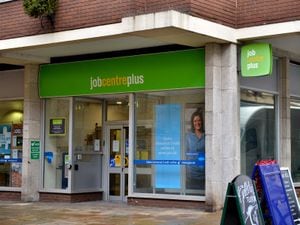More in work across Shropshire
The number in work across the West Midlands rose again in the three months to the end of June.

The latest Office for National Statistics figures also showed another drop in the region's unemployment rate for the period with the number claiming unemployment benefits mainly continuing to fall again in July.
UK worker numbers also rebounded further in July as the labour market recovery continued despite the initial winding down of the furlough scheme, according to official figures.
The ONS revealed that the number of UK workers on payrolls rose by 182,000 between June and July, although at 28.9 million it is still 201,000 lower than before the pandemic struck.
The statistics body also confirmed that the rate of unemployment had dipped to 4.7 per cent for the three-month period to the end of June.
Analysts had predicted that the unemployment rate would stay flat at 4.8 per cent for the quarter.
For the West Midlands where 2.79m were working and 146,000 were unemployed, the rate was five per cent with the employment rate rising to 74.5 per cent.
Nationally numbers claiming unemployment benefits, including Universal Credit, were 2.26m last month with the West Midlands figure down 5,325 to 237,380 (6.5 per cent of the working population).
In June Shropshire had 225 fewer claimants at 6,945 (3.6 per cent) with Telford and Wrekin dropping by 120 to 5,730 (5.1 per cent).
Powys also experienced a fall of 100 to 2,615 (3.5 per cent).
The ONS also reported a further surge in job vacancies nationally as firms seek to fill roles following the reopening of the economy, rising by more than 290,000 against the previous quarter.
Minister for Employment Mims Davies said: "There are positive signs of recovery in today’s jobs figures with the number of young people and older workers on payrolls up on the quarter and the employment rate increasing to 75.1 per cent.
“There is still work to do and we’re focused on helping employers fill roles through our Plan for Jobs – giving people of all ages the skills, support and experience needed to confidently land that next opportunity.”
Jennifer Beckwith, Confederation of British Industry head of employment, said: “With employment up and unemployment down, the labour market is showing further signs of recovery.
“Yet, with vacancies at a record high, employers are concerned that staff shortages are stalling their ability to grow and support the country’s wider economic recovery.
“Recent changes to self-isolation mean that firms can at last continue to operate more normally, even if short-term absences remain a concern for sectors reliant on younger workers awaiting their second vaccine.
“A wider test and release scheme must be implemented so that self-isolation remains properly targeted at those who risk spreading the virus.
“Longer-term, firms must continue to invest in the skills and automation that will underpin future growth. The government can also help by ensuring that the qualifications it funds include those in short supply and removing barriers hampering firms’ ability to recruit overseas workers.”
Jonathan Athow, deputy national statistician for economic statistics at the ONS, said: "The world of work continues to rebound robustly from the effects of the pandemic.
"The number of people on payroll was up again strongly and has now grown over half a million in the past three months, regaining about four-fifths of the fall seen at the start of the pandemic.
"Meanwhile, early survey figures show that the number of job vacancies passed one million for the first time ever in July.
"There was no sign of redundancies starting to pick up in our survey data ahead of the furlough scheme beginning to wind down, and Insolvency Service figures for July suggest the same."
British Chamber of Commerce head of economics, Suren Thiru, said: “The latest figures confirm that the UK jobs market is recovering strongly as the boost to demand from the easing of restrictions helped drive higher payroll employment in July.
“Record vacancies confirm ongoing recruitment difficulties. Although the changes to self-isolation rules will help, with many firms facing a more deep-rooted squeeze on labour supply from the impact of Covid and Brexit, staff shortages may persistently weigh on economic activity.
“Although labour demand is currently robust, with firm’s finances still recovering from Covid and skills mismatches likely to limit the extent to which those seeking jobs after furlough can move into available roles, unemployment may still drift somewhat higher in the near term.
“Alongside rapid retraining opportunities, government should extend the Kickstart scheme into 2022 and expand it to enable older workers to gain new skills and experience. A more flexible immigration system is also needed to ensure that firms get access to the workers they need.”
Matt Weston, UK managing director of global recruitment firm Robert Half, said: “The rise in pay rolled employment sits hand in hand with a sharp drop in those using the furlough scheme, indicating continued recovery in the UK jobs market. The increase in median monthly pay also falls in line with the shift towards a talent-driven recruitment market, where candidates have greater influence when agreeing terms with a new employer.
“While increased employment is good news for the economy, the gap between supply and demand is causing headaches for businesses who are struggling to find talent with the skills they need for recovery and growth.
“Businesses must be prepared to go the extra mile to secure the people they need, beyond offering competitive salaries, benefits and the flexible working arrangements that are now expected as standard. Businesses must demonstrate values that mirror candidates’ interests by developing inclusive company culture that fosters loyalty from existing employees and potential new joiners.”





